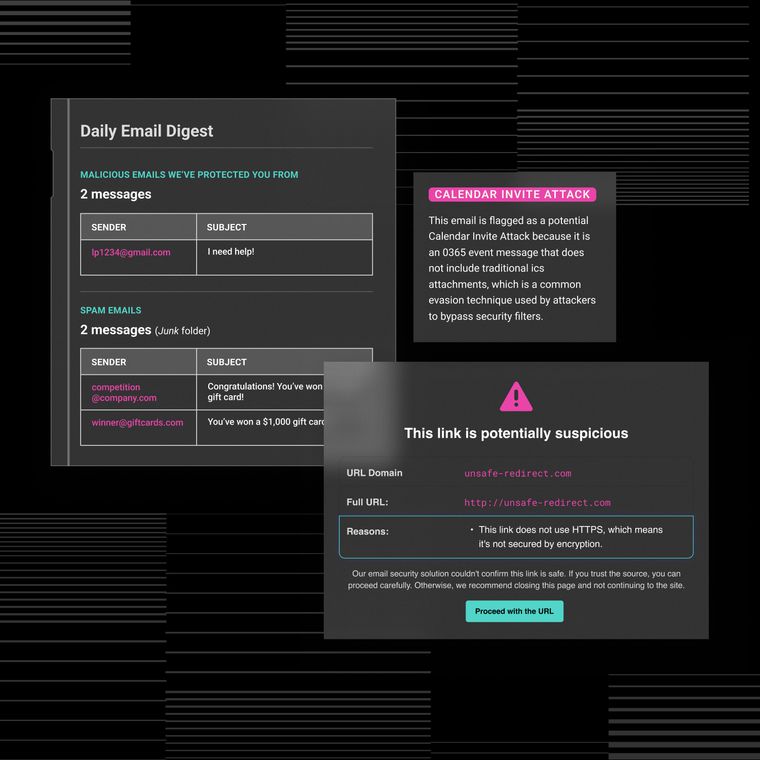Building an Effective Social Engineering Training Program: A Comprehensive Guide
Learn to build a comprehensive social engineering training program that reduces human-based security risk through role-based curriculum, simulations, and metrics.
July 8, 2025
/
5 min read
Social engineering attacks succeed because they exploit human psychology faster than organizations can deploy technical defenses. Employees who undergo proper security training are less likely to compromise credentials.
Social engineering is the deliberate use of deception, urgency, and authority cues to trick employees into handing over information, clicking a malicious link, or granting unauthorized access. Unlike technical exploits, these attacks target human judgment, not system vulnerabilities.
This means that even the most advanced email security gateway can miss a well-crafted social-engineering lure, which is why human reporting remains critical.
Attackers rely on five core tactics you need to recognize:
Phishing through fraudulent emails or messages that lure employees into clicking malicious links
Vishing via voice calls that impersonate support or executives to steal personal information
Baiting with tempting downloads or USB drives that hide malware
Quid pro quo offers of help or rewards that mask data-harvesting motives
Tailgating, where someone follows employees through secured doors to access devices or steal sensitive information
This guide walks you step by step through building a resilient training program, from policy framework to performance metrics, so you can reduce human-based risk.
Traditional defenses ignore the psychology behind decision-making. By focusing on how people actually think and act under pressure, you close the gap technology alone cannot address.
1. Establish Policy & Governance Foundation
A written policy is the backbone of your social engineering training program, setting non-negotiable rules that survive leadership changes and satisfy auditors. Draft a concise social engineering awareness policy that mirrors your risk appetite and regulatory mandates.
Your policy must define the following:
The purpose and scope, by specifying which systems, data, and employees the policy covers.
Roles and responsibilities, by assigning a program owner, technical subject-matter experts, and legal or HR liaisons who act when violations occur.
Enforcement mechanisms that define disciplinary steps for non-compliance and incentives for timely reporting.
Review cycles with version control that schedule annual reviews and maintain a changelog so no one acts on outdated guidance.
Build required completion rates for training directly into the policy. With governance established, you can confidently assess your current exposure.
2. Conduct Baseline Assessment & Risk Profiling
A data-driven baseline exposes exactly where your workforce is vulnerable, letting you direct budget and training toward the people and processes that actually need it.
Run Controlled Phishing Tests
Company-wide simulations that mirror real attacker tactics reveal immediate vulnerabilities. Track three metrics: click rate, credential submission rate, and time to report. Use tools like the AI Phishing Coach to simulate real attacks and create effective training programs.
Feed every result into your dashboard immediately to identify whether finance staff click three times more often than engineering or whether executives ignore the "Report Phish" button entirely.
Establish a behavioral baseline so you can quickly detect when an employee’s actions deviate from the norm. Flag repeat offenders for targeted coaching rather than disciplinary action.
Map Department-Level Risk
Simulations provide one view of exposure, but comprehensive risk profiling requires deeper analysis.
Pull help-desk tickets, incident logs, and prior breach data to uncover patterns. For example, invoice fraud emails that consistently reach accounts payable inboxes reveal systematic vulnerabilities.
Pair that hard data with an anonymous survey that captures employee confidence and preferred learning formats. Also, conduct surveys to find blind spots that metrics miss, such as contractors who never received onboarding training.
Rank departments by both likelihood and impact of compromise. Top tiers usually include finance, executives, and IT. Document the findings in a formal risk profile that lists specific vulnerabilities and recommended controls.
3. Design Role-Based Training Curriculum
Tie every lesson to the risks surfaced in your baseline assessment, then map tailored content and formats to each role so employees learn exactly what they must defend.
Build the Foundational Curriculum
Start with a universal track that makes every employee fluent in the threat patterns uncovered during assessment. Focus on three competencies:
Recognizing common lures
Reporting suspicious activity fast
Responding safely when mistakes happen
Ground each module in the underlying psychological triggers attackers exploit—authority, urgency, and reciprocity—so learners grasp why scams feel convincing. Use short videos, interactive questions, and real breach stories to maintain attention. Employees recall material better when they see how it played out for peers.
Reinforce concepts through monthly micro-learning nudges and quarterly drills. This rhythm turns an annual checkbox into steady behavior change and gives you clean metrics on knowledge retention.
Tailor High-Risk Modules
Layer specialized content onto the core track for departments facing elevated risk.
Finance teams should practice spotting wire-fraud requests that spoof suppliers. Executives should rehearse CEO fraud scenarios built around calendar pressures. And IT personnel navigate help-desk pretext calls aimed at privileged credentials.
Keep modules current by highlighting how attackers now use generative AI tools like WormGPT to craft highly personalized messages at scale. Build these lessons with role-based security awareness principles and deliver them through gamified exercises, leaderboard challenges, and live tabletop sessions.
Define one clear learning objective per scenario, validate technical accuracy with SMEs, craft a relatable story arc that mirrors real incidents, and embed immediate feedback with a "report" call to action.
Supplement every module with interactive learning formats so users practice decisions, not memorization. Real-world case studies and organization-specific data make the material stick and provide the detail executives expect when they review program efficacy.
4. Implement Training Delivery & Simulation Programs
Launch training in a tight 30-day window, combine it with realistic simulations, and track engagement metrics to harden employee defenses without overwhelming staff capacity.
Execute a 30-Day Rollout Timeline
Here’s an example of a 30-day rollout plan:
Days 1 to 5: Announce the program, brief managers, and enroll all staff in the learning platform.
Days 6 to 15: Release core micro-learning modules and push the first simulation.
Days 16 to 25: Run department-specific drills—finance sees invoice fraud, executives face CEO-fraud lures, IT tackles credential-harvesting emails.
Day 26 to 30: Publish performance dashboards showing click rates, reporting times, and repeat-offender lists. These dashboards should highlight abnormal click patterns, so you can easily spot departments that need extra coaching.
In parallel, verify that your SPF, DKIM, and MX record settings are correct so spoofed messages never reach employee inboxes.
Drive Engagement and Prevent Simulation Fatigue
Gamify every touchpoint by using team leaderboards, "quickest reporter" badges, and quarterly gift cards for top performers. Offer content on multiple channels, like in-person briefings, five-minute videos, and mobile-friendly quizzes, so shift and remote workers stay included. Immediate, constructive feedback appears after each simulation; employees who click see a 30-second explainer, not a punitive message.
Rotate templates monthly and escalate complexity for repeat clickers to keep scenarios fresh; static drills are associated with higher future failure risk according to best practices, though specific figures may vary. Monitor metrics—reporting rate, time-to-report, and participation—through a live dashboard and adjust frequency or content when engagement dips below baseline.
5. Measure Performance & Optimize Continuously
If you cannot quantify progress, your social engineering program is guesswork, so start treating measurement as a living control, not an afterthought.
Begin with a tight set of risk-focused KPIs:
Click-through rate on simulations
Median time to report suspicious messages
Reporting rate versus click rate
Repeat offender percentage
Credential submission and data exfiltration attempts, recorded during tests
Real-world incident volume linked to social engineering
These indicators reveal both competence and remaining exposure. For example, the reporting rate is a stronger predictor of resilience than simple non-clicking behavior.
Translate raw numbers into executive language. Build a dashboard that rolls KPIs into a single "risk reduction score," and trend it quarter over quarter. Visualizing how the click rate drops while reports rise lets you demonstrate tangible progress at the board level.
Optimization is cyclical. Schedule quarterly reassessments: rerun baseline surveys, launch new simulations, and fine-tune role-based modules for departments that still show high failure or low reporting. Continuous testing matters; weekly simulations drove a 2.74-times larger risk reduction than quarterly campaigns.
Tie security outcomes to dollars. Estimate avoided breach costs, reduced help-desk tickets, and reclaimed productivity to calculate ROI—then benchmark those figures against industry data sets.
Secure Executive Buy-In & Budget Approval
Executive approval requires demonstrating clear ROI through quantified risk reduction and cost savings. Translate security KPIs into dollars by detailing every avoided breach, faster reporting time, and drop in click rate equals fewer incident‐response hours and compliance penalties.
Condense your business case into one slide:
A baseline-versus-target table
A 30-day rollout timeline
A simple ROI formula (cost of program ÷ estimated loss prevented)
Boards react to clear numbers, so place incident reduction and productivity gains in bold, not technical jargon.
Prepare for budget pushback by positioning training as business enablement. Incident investigations already consume staff time; a mature program trims those hours while protecting brand trust. Fewer disruptions mean faster deal cycles and smoother audits.
Commit to visibility through quarterly security behavior dashboards. Tie funding to measurable milestones, such as high course completion rates within the first two months, and a significant improvement in 'time-to-report' (for example, aiming for a 20% to 30% improvement) by month three, based on organizational goals. Executives fund what they can track, so give them a scoreboard.
Build Sustainable Security Culture
Sustained defense against social engineering requires embedding security awareness into daily operations, not relying on annual training events.
Include role-specific social engineering modules in new hire orientation before employees receive system access. This ensures staff understand reporting procedures from day one and establishes security as an organizational priority.
Schedule monthly touchpoints that integrate seamlessly with existing workflows: micro-learning videos, quick assessments, or case studies from recent attacks on peer organizations.
Appoint security champions within each department to translate policy into team-specific language and facilitate incident debriefs. Recognizing ambassadors during company meetings demonstrates leadership commitment and normalizes open discussion of security mistakes.
Refresh simulations and training materials quarterly to reflect emerging threats from current intelligence feeds. This continuous cycle—onboard, reinforce, champion, evolve—transforms training from compliance activity into organizational reflex that adapts to the changing threat landscape.
Turning Awareness into Lasting Defense
Social engineering thrives by targeting human behavior, not just systems, which is why effective defense starts with people. A resilient training program teaches employees to recognize key attack tactics like phishing, vishing, and baiting while grounding each lesson in psychological principles. When training is tailored to roles and real-world scenarios, users are more likely to spot and stop attacks before they succeed.
But awareness alone isn’t enough. Organizations must track metrics like click rates, time to report, and repeat offenses to measure progress and justify investment. Executive buy-in depends on translating these metrics into business outcomes, like fewer incidents, faster response times, and reduced operational costs. A structured rollout and continuous optimization ensure that training stays relevant and impactful.
The real goal is to build a sustainable security culture. This means onboarding every new hire with clear expectations, reinforcing behavior through microlearning, and empowering department-level champions to lead by example.
Book a demo to see how Abnormal can help your organization implement smarter, behavior-driven protection.
Related Posts
Get the Latest Email Security Insights
Subscribe to our newsletter to receive updates on the latest attacks and new trends in the email threat landscape.


